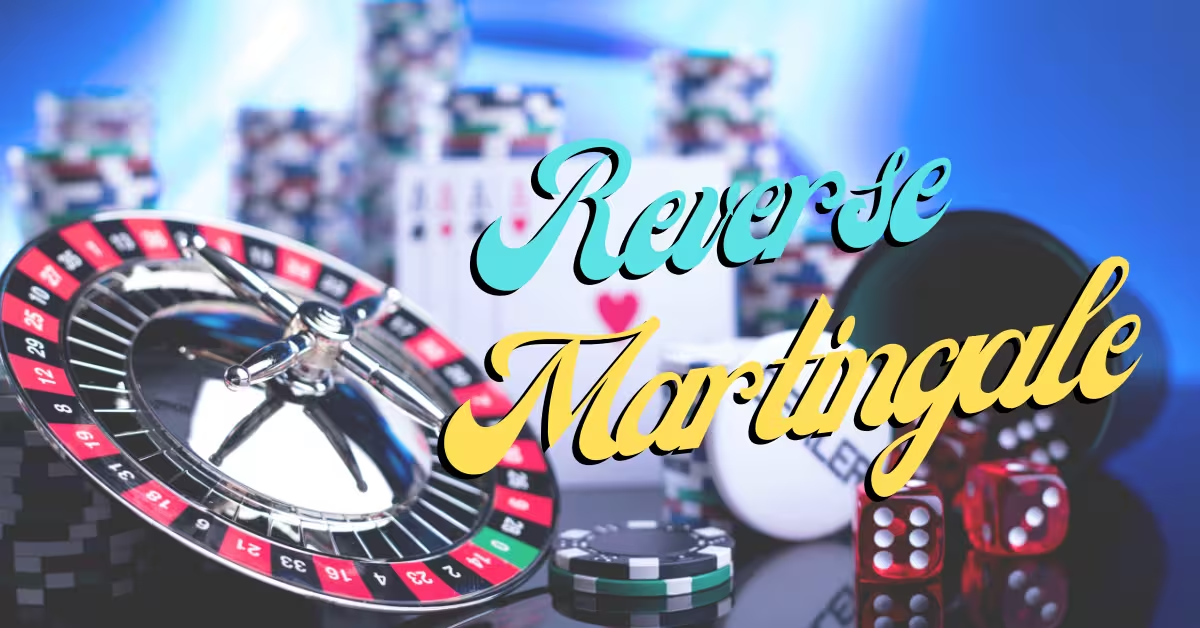The Reverse Martingale: Risky or Revolutionary?

Gambling lovers are always on the lookout for a betting strategy that could tilt the odds in their favor.
And one that they use? It’s called the Reverse Martingale, and it is said that if used correctly, you can double your bet when you win instead of when you lose. Is it risky? Heck yeah, all gambling is!
But is it more risky? That’s what we are gonna find out! In our comprehensive guide, we’ll examine how the Reverse Martingale (also known as the Paroli system) works, where players use it, and how it compares to other strategies like the Martingale, Flat Betting, and Fibonacci systems!
What Is the Reverse Martingale Strategy?
The Reverse Martingale, or Paroli system, is a positive progression betting strategy built around the idea of doubling your wager after each win. You basically press your luck when you’re winning and cut back when you’re losing.
It’s the opposite of the classic Martingale strategy (which doubles bets after losses). The core belief behind Paroli? Winning streaks do happen, and when they do, the system can maximize profits from a hot run and keep losses small during cold streaks.
After a loss, you drop back to your original base bet, limiting the damage. It’s a simple concept: “let your winners run and cut your losers.” But how does it play out in practice, and where do gamblers use the Reverse Martingale?
Reverse Martingale vs. Traditional Martingale
It’s helpful to compare the Reverse Martingale to its namesake, the traditional Martingale, to really grasp the differences. Both are betting progressions, but they’re mirror opposites in approach:
You double your bet after every loss with the goal to eventually win and recover all prior losses plus one unit of profit.
A Martingale bettor could wager $10 and lose, then bet $20 and lose, then $40 and lose, then $80 and win, at which point that $80 win covers the $10+$20+$40 lost earlier and nets a $10 profit.
Martingale offers frequent small wins (almost every successful cycle yields just the original bet as profit) but comes with a big risk of a huge loss. A long losing streak can balloon bets to enormous sizes, hitting table limits or bankrupting the player. It’s not uncommon for a Martingale user to wipe out a large bankroll for the sake of winning just a teeny amount in the end.
Paroli is a positive progression: you double your bet after every win, and revert to your base bet after a loss (or after a predetermined number of wins). The goal with this is to capitalize on a hot streak and compound a series of wins into a big profit, while keeping losses flat and small. In a winning scenario, Paroli can yield a way bigger profit than Martingale in the same number of bets (because you keep parlaying your winnings). If you start with $10 and win three in a row with Paroli, you’d parlay $10 → $20 → $40 and end up with $70 net profit when you stop, versus a Martingale player who may have won three in a row but only increased their bet after losses, meaning they just net a $10 profit for that whole stretch.
But Reverse Martingale has its own trade-off: it produces frequent small losses (your base bet) in exchange for the chance at an occasional sizable win. Most of the time, you’ll win a couple of bets and then lose one, which often means you give back the small profit you had and end up roughly at a net zero or a small loss for that cycle. Only when you hit an uninterrupted winning streak do you see a significant net gain. Paroli flips the Martingale risk profile: instead of a lot of small wins and one huge loss, you get a lot of small losses and one huge win. And one big loss at the wrong time can wipe out your accumulated gains from a streak if you haven’t banked them!
Where can you use the Martingale System? The three games where it’s practiced are below:
Roulette
Roulette is the spiritual home of the Reverse Martingale. Players often apply Paroli on even-money bets like red/black, odd/even, or high/low outcomes. For example, you might start with a $10 bet on Black. If Black hits, you win and then double your next bet to $20 on the following spin. Win again, and you press to $40 on the next spin, and so on. If at any point you lose (or after you’ve achieved a set number of wins in a row), you reset back to the $10 base bet.

The appeal in roulette is clear: you’re trying to ride a lucky streak of reds or blacks and walk away with a hefty profit while each losing spin only costs you a small base amount.
This works best on European or single-zero roulette wheels for the higher odds (~48.65% chance on an even bet each spin), but many players still attempt it on American double-zero wheels as well. The strategy flows naturally with roulette’s pace – each spin is an independent event, and Paroli lets you capitalize if luck clusters some wins together. Importantly, roulette’s table limits rarely pose a problem for Paroli in the way they do for Martingale. Since your bets grow only after wins, they typically stay modest; a $10 starting bet would only reach $40 after three consecutive wins, well within limits at most tables.
Blackjack
Blackjack players can and do use the Reverse Martingale, though the strategy requires a lot of discipline. You place a base bet (like $25) and follow basic strategy for the game itself. If you win the hand, you’ll double your wager to $50 for the next hand. Win again, go to $100, and so on. Any time you lose a hand, you drop back to $25.

The idea is the same: press your bets when you’re “running hot.” Blackjack’s dynamics add a few wrinkles, however. Because you might encounter situations like splits or double-downs, you need a sufficient bankroll buffer; if you’re on a streak and need to split a hand or double down, the effective money on the table can grow unexpectedly.
Paroli in blackjack is best attempted at tables with low minimums relative to your bankroll (so you can weather some dry spells) and under conditions where you stick to basic strategy.
Baccarat
Baccarat is another favorite game for the Reverse Martingale. The game’s simple bet options, which are Banker or Player, are pretty close to 50/50 outcomes, making them suitable for Paroli.

Most players prefer the Player bet for this system (to avoid the 5% commission on Banker wins), giving roughly a 49% chance of winning each coup. Using Paroli in baccarat works like this: bet, for example, $20 on Player. If you win, let it ride by betting $40 on the next round; win again, go to $80, and so forth. After a loss, revert to $20. Baccarat’s calm, steady pace and low volatility in even-money bets align nicely with Paroli’s philosophy. You want to catch a streak of Player (or Banker) wins and parlay them into a sizable score. The Banker bet’s slight edge (despite the commission) can also be used for Paroli, and some bettors stick with Banker under the reasoning that it wins a tad more often.
Step-by-Step Example of the Reverse Martingale
To really grasp how the Reverse Martingale (or Paroli) system plays out, we are gonna walk through a few simple scenarios using a base bet of $10. The examples highlight how the system compounds wins during a hot streak and contains losses when things don’t go your way!
Scenario A: 3-Win Streak Using Reverse Martingale (Paroli)
| Bet # | Bet Amount | Outcome | Running Total |
|---|---|---|---|
1 | $10 | Win | +$10 |
2 | $20 | Win | +$30 |
3 | $40 | Win | +$70 |
Explanation:
- You start with a $10 base bet. After each win, you double the next wager
- If you win all three in a row and stop there (which many Paroli users do), you turn $10 into $80 total (your original stake plus $70 in profit).
- The entire $70 gain comes from riding the streak, not increasing losses.
Scenario B: 3-Loss Streak Using Reverse Martingale
| Bet # | Bet Amount | Outcome | Running Total |
|---|---|---|---|
1 | $10 | Lose | -$10 |
2 | $10 | Lose | -$20 |
3 | $10 | Lose | -$30 |
Explanation:
- You always revert to your base bet after a loss, so there’s no escalation.
- Even after three straight losses, you’ve only dropped $30, which isn’t great, but it’s not bankroll-breaking.
- This is the main appeal: you take hits, but they’re all flat and manageable.
Bonus: Win-Win-Loss Scenario (What Most Sessions Look Like)
| Bet # | Bet Amount | Outcome | Running Total |
|---|---|---|---|
1 | $10 | Win | +$10 |
2 | $20 | Win | +$30 |
3 | $40 | Loss | -$10 |
Explanation:
- You win the first two bets and lose the third.
- That last loss wipes out all the gains, plus your original $10.
- It’s the usual Paroli result: get close to the winning goal, then one loss changes the outcome.
- This is why having a stop-win rule, stopping after 2 wins instead of 3, is important.
Why Some Gamblers Love It
Despite being unable to overcome the casino’s built-in edge, the Reverse Martingale has some attractive features that explain its popularity among gamblers, including the following:
Limited Downside on Each Round
Maybe the biggest selling point of Paroli is that you never chase your losses by increasing bets after a loss. Every new betting sequence starts at the same small base amount. This means that if luck is not on your side and you keep losing, your losses accumulate linearly, not exponentially. If your base bet is $10 and you lose ten times in a row (a brutal run), you’ll lose $100 total, which sucks, but it’s not devastating for most bankrolls.
A Martingale player in that scenario could have lost thousands by the tenth bet or hit a table limit. Most players take comfort in knowing that, with Reverse Martingale, a long losing streak won’t bankrupt them; they can keep playing and get many “at bats” to try and catch a hot streak.
‘Playing with House Money’ Feeling
After you win that first bet in a Paroli sequence, the money you’re doubling for the second bet is largely the casino’s money (your winnings). Similarly, if you win two in a row, the third bet mostly consists of money you’ve won from the house, and so on. Psychologically, this feels amazing. Since you’re parlaying winnings, each subsequent bet in a streak doesn’t feel like you’re reaching into your own wallet; you’re wagering your winnings!
Big Wins Are Possible (Even on a Small Bankroll)
Using Paroli, it only takes a few consecutive wins to snowball a tiny bet into a significant payout. This is a major draw for players with limited bankrolls who dream of hitting it big. If you start out with just $5, a streak of 5 wins in a row would turn that into $160 (since 5 wins, doubling each time, multiply the money 32-fold). A $10 start with 5 wins becomes $320. The dynamic creates a lottery-like aspect to Paroli: most of the time, you won’t get those 5 wins in a row (far from it), but occasionally you might, and that payoff is super attractive. Betting systems don’t really offer the chance to, say, turn $10 into $300+ in a short span; Paroli does (albeit with low probability).
Simplicity and Clear Structure
The Reverse Martingale is really simple to execute! There’s no complicated sequence to remember (unlike some systems that have you increase by specific increments or follow a numeric pattern). With Paroli, it’s binary: did you win? Double the bet next time. Did you lose? Go back to the starting bet. Repeat. This clarity makes it easy to follow without mistakes, even in the middle of a casino session.
The Risks behind the Hype
For all its appeal, the Reverse Martingale system still has risks and limitations that every player has to understand! The casino’s edge doesn’t disappear just because you’re using it. Below are the main drawbacks and why Paroli, like all betting systems, can’t guarantee long-term success (nothing can):
House Edge Still Rules
First and foremost, the Paroli system does not change the odds of the games you’re playing. Each bet is still subject to the house edge; roulette’s even-money bets still only win ~47.4% of the time on an American wheel or 48.65% on a European wheel, and blackjack still yields a slight disadvantage to the basic strategy player over the long run, etc.
This means that over a very long timeline, if you keep playing, the casino will mathematically expect to take a cut of your money. The Reverse Martingale doesn’t change that fact; it just rearranges the pattern of wins and losses. What Paroli might do is give you different short-term outcomes (maybe you walk away a winner one night and a loser another night, instead of small wins every night, then a big loss), but if you played indefinitely, the end result would gravitate toward losing the same percentage of your total bets as any other method.
The Odds of Long Winning Streaks Are Low
Paroli’s whole profit logic hinges on getting consecutive wins. But as anyone can intuit, stringing together multiple wins in a row is way less likely than a single win. Even in a nearly 50/50 game, the probability drops sharply with each extra win needed.
The chance of winning three bets in a row in European roulette is only about 11.5%. Going for five wins in a row? That probability falls to about 2.7% (about 1 in 37). If you demanded a streak of 10 in a row, the odds are super small (around 0.09% or 1 in 1,000 for a fair coin toss game).
What this means is that if your Paroli strategy aims for a long streak, you will very rarely, if ever, hit that target. You can try cycle after cycle with nothing to show for it until that rare streak comes (if it comes at all before you run out of time or money). And when you do hit it, while it will pay off nicely, it will probably only compensate for all the small losses you took in trying.
One Loss Can Wipe Out a Cycle’s Gains
With Paroli, all the profit from a streak is on the line until you actually finish the streak and bank it. If you lose before reaching your stop point, you usually end up with little to no profit from that sequence.
We saw this in the example above: two wins and then a loss resulted in a net -$10 when aiming for three wins. And two wins in a row, followed by a loss, left the player exactly where they started (actually a tiny loss in that scenario). The risk is front-loaded onto the final bet of your streak. That last double (be it the second, third, or fourth in your sequence) is usually for an amount larger than your initial bet, and if it fails, you don’t get to keep the accumulated winnings; they disappear.
Regular Small Losses Do Add Up
Although each individual loss in Paroli is small, if you experience a lot of them consecutively? The add up! It’s not uncommon to have a session where you just don’t hit any significant streak, and you might drop a unit almost every round for a while. If you’re unlucky and never hit the streak you’re hoping for in a session, you can still walk away with a significant loss. It’s not as bad as a Martingale bust, but it is a slow bleed. This can happen if the player isn’t strictly stopping after a set goal and keeps chasing a streak throughout a long session.
No Guarantee of Profit: It’s Still Gambling
This should go without saying, but we still need to say it: the Reverse Martingale does not guarantee any profit or “beat” the game mathematically. There are novice players who mistake it as a “safe” system since the bets don’t escalate on losses.
And while it is safer in terms of avoiding a catastrophic loss, it’s not a strategy that will systematically produce winnings. The outcomes are all dependent on short-term luck. Paroli doesn’t explicitly assume a win is more likely after a win (it just says “if it happens, capitalize on it”), players might get into a mindset of expecting clusters. It’s important to be aware that streaks are random and unpredictable. The Reverse Martingale will have you risk increasing amounts when those random streaks happen, but it won’t make streaks occur any more often.
Table Limits and Practical Constraints
This is not as big an issue as with Martingale, but table limits can still cap a Paroli run. If you start at $5 on roulette and keep doubling through a lucky run, you might eventually hit the table’s maximum bet, at which point you can’t continue the progression.
For example, a $5 base bet turning into $5 → $10 → $20 → $40 → $80 → $160 → $320 → $640 → $1280 → $2560… if the table max is $1000, you’d hit that before the 8th win. Granted, the probability of getting 8 wins in a row is extremely low, and most Paroli users set a stop well before that, but it’s theoretically possible to run into limits if you ever got extraordinarily lucky (or if you started with a larger base bet relative to the max).
Bankroll limits are also a factor: even though Paroli doesn’t require a huge bankroll compared to Martingale, you still need enough to ride out a lot of attempts. If you plan to only risk $100 in a night and you’re betting $10 units, you can only afford 10 lost bets before you’re tapped out. If none of those 10 attempts yields a streak, you’re done.
Reverse Martingale vs. Other Popular Strategies
There are a lot of betting systems out there, each with its own philosophy on when to increase or decrease bets. To put the Reverse Martingale in context, let’s compare it with a few other well-known strategies: Traditional Martingale, Flat Betting, and the Fibonacci system, across a few main attributes.
Look at the chart below for a summary of how the strategies differ in terms of when bets increase, what the primary goal is, and their relative risk level!
| Strategy | When Bets Increase | Primary Goal | Risk Level |
|---|---|---|---|
Martingale | After every loss (double the bet after a loss) | Recoup all losses with one win (and gain +1 unit profit). | High – Can lead to very large bets and potentially huge losses if a long losing streak occurs. Table limits and bankroll caps are major issues. |
Reverse Martingale (Paroli) | After every win (double the bet after a win) | Capitalize on winning streaks; turn a series of wins into a large profit, while limiting losses per cycle to the base bet. | Moderate – Small losses are common, but no rapid bankroll escalation. But a single loss can forfeit streak winnings, and success relies on hitting rare streaks. |
Flat Betting | Never! The bet stays the same every round, regardless of wins or losses. | Maintain consistent play and rely on the game’s odds in the long run; avoid volatility altogether. | Low – Minimal volatility. No bet progression means you won’t face big swings, but you also won’t recover losses or amplify wins quickly. You are at the mercy of the house edge over time. |
Fibonacci System | After a loss (increase following the Fibonacci sequence: e.g., 1, 1, 2, 3, 5, 8, …) | Gradually recover losses over a series of bets. Each win ideally covers the sum of the two previous losses. | Medium – Slower escalation than Martingale, reducing the risk of hitting limits, but can still reach high bets if many losses occur. Less volatile than Martingale but more so than flat betting. A long losing streak can still be costly. |
When (If Ever) to Use It
Given the pros and cons we’ve covered, should you use the Reverse Martingale system, and if so, when? The honest answer? It all depends on your goals and the context. The following are some scenarios and considerations for using Paroli, along with advice on doing so responsibly:
The Reverse Martingale is best for relatively short play sessions where you have a clear exit plan. If you walk into a casino or log into an online casino with a modest bankroll and a mindset of “I’m going to take a shot, and if I get lucky early, I’ll leave up,” Paroli can fit that style.
You choose the roulette table and have a bankroll of $100. You decide to bet $5 on red with Paroli rules, and you’ll leave if you manage to parlay that into a 3-win streak at any point (which would turn $5 into $40 profit). If luck smiles upon you and you hit that within a dozen spins? Amazing! You’re up $4,0 and you call it a night. If it doesn’t hit, the worst-case scenario is you lose your $100 over a lot of spins.
Paroli is good for games where the win probability is close to 50%. So the ideal environments are roulette (especially European single-zero roulette with its 2.7% house edge), baccarat (1.2% edge on Player, 1.06% on Banker with commission), blackjack (around 0.5% with perfect basic strategy, though real win rate per hand is slightly less due to pushes), or possibly craps (pass/don’t pass around 1.4% house edge) on pass line bets.
These games give you the best fighting chance to hit a streak before probability says you likely fail. Also, consider sticking to single-zero roulette tables if available, because the higher your win percentage, even marginally, the better Paroli will perform.
Use Reverse Martingale if your goal is to maximize fun and potential excitement in a gambling session, not if you are looking to grind out consistent winnings. If you’re the type of player who enjoys the chance that “maybe I’ll double and double and double this into a big stack,” then Paroli matches up with your style. But if you like slow and steady play or get anxious about losing multiple bets in a row, Paroli is probably not for you.
Yes, we have hammered on this, but it’s so important: only use Reverse Martingale if you are prepared to set strict limits and stick to them. This means both stop-win and stop-loss thresholds. A stop-win might be “if I turn $50 into $150, I’ll lock it in.” A stop-loss might be “if I drop $50 with no streak, I’ll call it quits for the day.” The worst outcome is to hit a great streak, be up a lot, and then keep gambling it away. Eventually, a streak won’t complete, and you could surrender some or all of your profit.
If you decide to use Paroli, choose a base betting unit that is small relative to your total bankroll. This way, you can survive lots of cycles of losses without tapping out. In an online casino setting, if you have $200 deposited, you might use $2 or $5 as your base bet, not $25. Low minimum tables or online games make it easier; many online platforms let you bet as low as $1 on roulette or baccarat. Online casinos like BetMGM or Caesars Palace have low minimum versions of these table games, so they’re solid places to try a Paroli system without risking big amounts. Keep your unit size to 1-2% of your total session bankroll as a common rule of thumb. This way, dozens of small hits won’t wipe you out.
Expert & Community Opinions
What do pro gamblers and gambling experts have to say about the Reverse Martingale (Paroli) system? The opinions are mixed, ranging from cautious endorsement as a “less bad” system, to outright reminders that it’s not a winning strategy in the long run. Below is a sample of some sentiments from both gambling experts and the player community:
Expert Analysis
Gambling mathematicians like Michael Shackleford (known as the Wizard of Odds) have analyzed progressive betting systems and note that Paroli, like all such strategies, cannot alter the house edge or guarantee profits. Experts acknowledge that if you play indefinitely, Paroli will not save you from the inevitability of the odds. But experts also tend to agree that as far as betting systems go, Reverse Martingale is relatively kinder to the player’s risk profile. It’s said that Paroli is a “safer” approach than Martingale because you’re not risking exponential losses. In one analysis of various systems using Markov chains and computer simulations, Paroli was shown to have the same expected value as flat betting (as expected) but with higher variance, meaning bigger swings both positive and negative.
Experts like to emphasize that discipline is critical: they advise setting a cap on consecutive wins (commonly 3 as a sweet spot) and a plan for stopping play, otherwise even the Paroli system will ultimately drain your funds.
Gambler Community Sentiment
On gambling forums like Reddit, you’ll find tons of discussions about Reverse Martingale where players share personal anecdotes: some recount nights where Paroli delivered huge wins (“I ran $10 into $160 by catching a lucky streak; best feeling ever!”), while others share cautionary tales of long dry spells (“Tried it all night, never got past two wins in a row, ended down a bunch of units, sigh”). A common theme from community members is that Paroli is great for preserving your bankroll during bad luck, but it absolutely relies on good luck to make you money. There’s an appreciation that Paroli lets you play longer with a limited bankroll, since you’re not pressing when you’re losing.

Some community members also mention using modified Paroli strategies, like the 1-3-2-6 system (a specific positive progression where you bet 1 unit, then 3, then 2, then 6 on wins), which is basically a structured Paroli variant with a built-in stop after 4 bets. They report that such systems can produce nice wins when a short streak hits, and limit losses to a couple of units when it doesn’t. Overall, the community tends to be more favorable towards Reverse Martingale than Martingale, viewing it as a “high risk, high reward, but at least the risk is capped” method.
References in Gambling Literature
If you look at gambling books and historical anecdotes, positive progression systems like Paroli have been around a long time (the term “Paroli” itself comes from a Latin word for “one that is equal” or a doubling, with usage dating back centuries). Many gambling authors note that Paroli was often recommended by old-timers as a way to “play with the casino’s money.”
Some 20th-century gambling manuals suggested using Paroli in games like baccarat or even sports betting as a method to capitalize on hot streaks of wins, with strict rules to stop after a few doubles.
They argued it provided a psychological edge; you’re essentially free-rolling after the first win. Modern authors, armed with computers to simulate millions of rounds, acknowledge that while Paroli doesn’t beat the odds, it can be part of a sound money management approach if the goal is to maximize your chances of a big win in a short timeframe.
Our Verdict: Risky or Revolutionary?
The Reverse Martingale (Paroli) system does offer a combo of risk and reward. It’s revolutionary in its attitude; you press your luck when things are going well, but it’s also undeniably risky in that it banks on that luck continuing.
We’ve learned that while Paroli won’t alter the fundamental odds, it can change your gambling experience by capping losses and giving you shots at a big win. If you find it intriguing or aren’t interested, the way to use any betting strategy is with a smart and disciplined approach.
Look below for the main takeaways about the Reverse Martingale System:
- The House Still Wins: No system, including Paroli, changes the casino’s edge. Use it for fun or bankroll structure; never as a guarantee.
- Quit While You’re Ahead: Paroli is about riding streaks, so set a profit goal or win cap, then stop. Discipline is what makes it work.
- Limit Your Losses: Decide ahead of time how much you’re willing to lose. Paroli uses small bets, but repeated losses can still deplete your bankroll.
- Start Small, Stay Small: Use base bets of 1–2% of your bankroll. Resist that urge to raise stakes after losses; that’s how you fall into Martingale traps.
- It’s a Game, Not a Paycheck: Think of Paroli as structured fun. If you win big, great! But treat it as a bonus, not a plan.

Alyssa contributes sportsbook/online casino reviews, but she also stays on top of any industry news, precisely that of the sports betting market. She’s been an avid sports bettor for many years and has experienced success in growing her bankroll by striking when the iron was hot. In particular, she loves betting on football and basketball at the professional and college levels.







